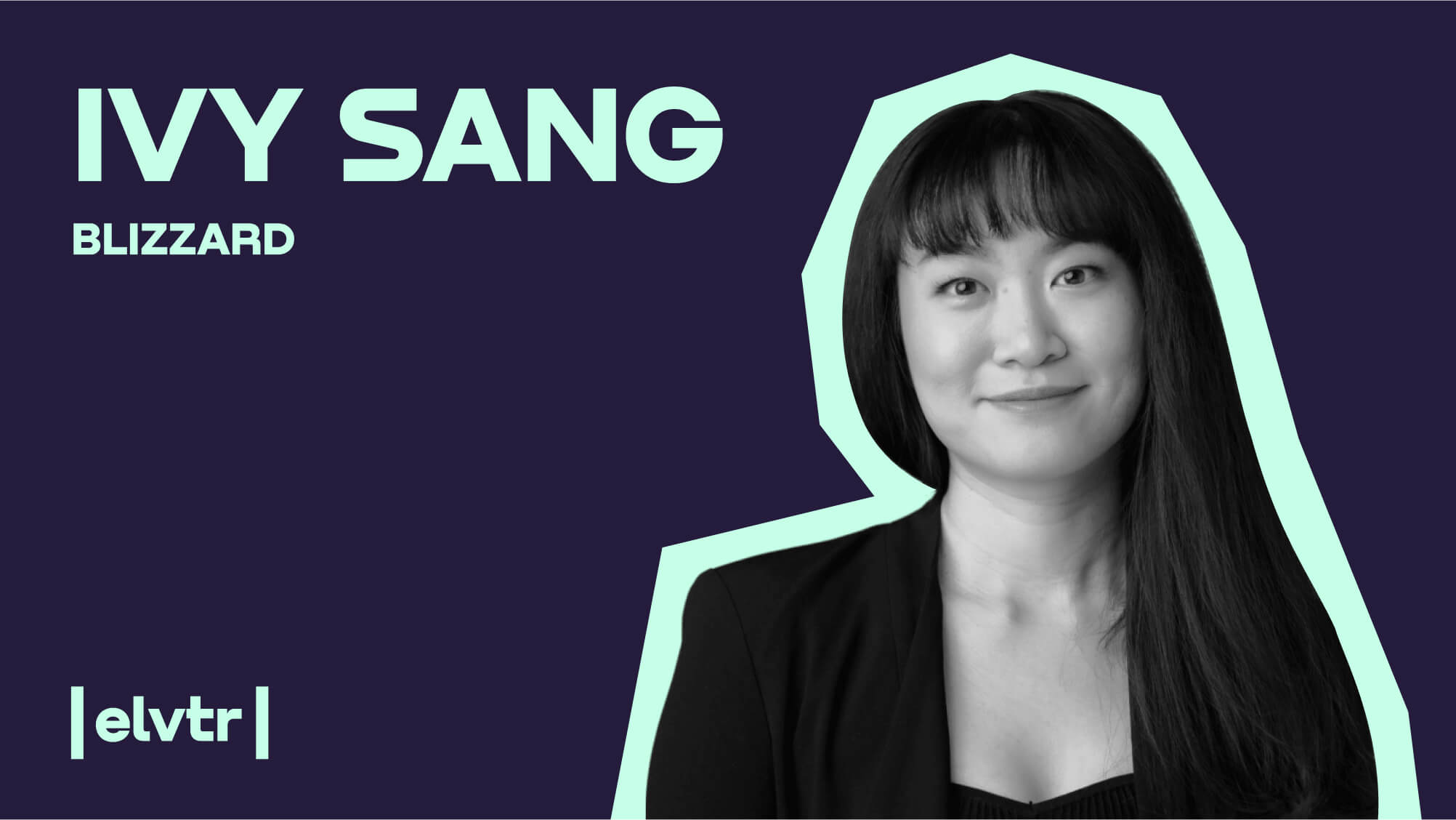- MAIN PAGE
- – elvtr magazine – WHAT DOES A UX GAME DESIGNER ACTUALLY DO?
WHAT DOES A UX GAME DESIGNER ACTUALLY DO?

Is passion for gaming, coupled with a bit of talent, enough to break into gaming? Absolutely, replies Ivy Sang, UX/UI Lead at the gaming powerhouse Blizzard. With legendary titles such as FIFA, NHL, UFC, Battlefield and Diablo 4 under her belt, she’s now keen to help more professionals break into this burgeoning industry through her course on UX/UI for Gaming.
Ivy sat with ELVTR for a chat on what it takes for a designer to transition into gaming UX/UI, the benefits and challenges of working in the industry, and why Super Smash Bros is still her favorite game.
How did you become a game UX/UI designer?
Before I got into the gaming industry, I was working in tech. That's where I learned UX/UI and product management. I had academic training before that in digital design, but I wasn't looking for a job in gaming.
I got some offers from gaming studios, which was quite a surprise to me. So I landed a job to see what would happen. Once I started, I fell in love with UX/UI for video games and I have been in this industry for a decade.
What advice would you give to someone who wants to follow the same career path?
If you want to work as a UX/UI designer in technology or gaming, don't limit yourself to UX/UI design. You can get inspired and discover many different ways of expressing yourself. Other people provide great design experiences for customers without necessarily having that title.
My course includes a class where I use a snow tire salesman as an example of how to create a good customer experience for video games. I also draw inspiration from daily life, for example how IKEA sets up the customer experience, whether you're the customer or you're just looking around in-store.
We can also learn from bad experiences. Not as a critique, but rather to think “If there was anything that could be done differently, what would that be?”, like a risk analysis in retrospect. For a designer, it’s a good exercise to think: “If I need to deal with a similar situation while designing a video game, how can I solve this problem?”
What are the main differences from non-gaming UX/UI design?
The medium is different. The reason why it’s important is that you have to understand its limitations and constraints. When you create a video game you need to be aware of what’s technologically feasible. You need to work with programmers, artists and designers to implement your vision. There are things that we just can’t make happen, even if that’s frustrating or annoying. You just need to respect the limitations and constraints; then be creative about how you approach solutions.
For other types of design, like the IKEA experience, the medium is more physical, a construction space of building, interior design, in-person service. You hire people who can speak a particular language or are able to provide a personalized experience.
So different media have different design limitations. The way we approach these limitations are actually similar, it’s just the content that is different.
What sort of knowledge of cognitive science is needed to create fascinating player journeys?
For video game development, there are two areas. If somebody is coming from tech UX/UI, they are probably familiar with the first layer, which is usability. Do people actually understand the game? Is it usable? Can people just learn and complete it, without any assistance, confusion or frustration? If players cannot have a good time and they are frustrated, they can't really enjoy the game experience. You want people to feel good.
An additional layer that differentiates the video game experience from other tech industries is desirability. Some students are experienced UX designers, but they struggle with that aspect when transitioning into gaming.
In other kinds of UX /UI design, for example if you launch a banking app or an education website, you don’t care that much about whether people like the storytelling or the art style as much as with video games and other entertainment products. The purpose is not entertainment, it’s providing a tool to help users bank quicker and more efficiently.
But in gaming, it's vital for your success. You need to get the experience right. So whenever we're creating games, one thing we consider is whether players will like a concept, an item or a character.
For example, in the game I'm currently working on now, Diablo 4, there are certain things we need to consider. If I make this change, will people like it? That's something cognitive science helps us with: understanding what players think, what their preferences are, and what factors influence these preferences.
Is that why it’s important to create accessible and approachable user experiences?
It’s linked to it, but slightly different. Creating accessible and approachable experiences is about how we can create a sense of belonging for a diverse group of people. Desirability and usability are vehicles to achieve an approachable and accessible experience, and eventually a sense of belonging.
You can achieve that in different ways. That's the creative part when you work as a UX/UI designer: understanding the players and creating something they desire to imbue a sense of belonging.
What’s the role of usability tests in this process?
I use usability tests as an introduction to the way we approach user research in gaming. As designers, we want to create a good user experience and that requires understanding all players. Usability tests are an example of that.
So I am showing students how they can understand players, how they can interpret player feedback, and incorporate that into design. In other words, usability tests are an example of how to plan, conduct and report that sort of research and utilize it in collaboration with developers.
Recommended courses
Your course includes building flowcharts on Figma. Any other technical skills a UX/UI game designer should master?
They're very similar to tech UX/UI. What’s different is the success metrics. In gaming, when you design all UX/UI tasks, including player journeys, flow charts, wireframes, UI mockups, you need to achieve both usability and desirability for a good video game experience. In other kinds of tech, normally we put more emphasis on usability.
You start with user stories or player journeys, Flowchart, Wireframe. On the artsy side, you can set up a UI art style guide and UI art mockups. Overall, the technical skills should focus on how to create usability and desirability while working on a design task.
You are the UX/UI Lead at Blizzard - what’s your workday like?
Currently, I have a leadership position. So my daily work does not focus on actual design anymore, but handling a team, helping to remove the roadblocks and supporting them to achieve their career goals.
Also improving their wellbeing and helping them to have a work life balance. My philosophy is that we're creating fun for other people, so we should be having fun ourselves too.
Another big chunk is working with other directors to define what our ultimate goals and vision are. That involves identifying next steps for our games, so that we can align our goals to have a clear understanding of targets from a design perspective, but also of limitations from a production perspective.
Then I engage our UX professionals to set out how we can achieve these goals as a team and work on specific tasks.
What do you enjoy the most and least about it?
The thing I like the most is supporting other people and creating a good experience for people around me. Also overseeing that kind of work and setting out the vision and goals with other leaders.
What I don't enjoy is that this industry still has some issues in terms of creating an inclusive, diverse culture and team environment for everybody. I am a female designer and also an immigrant. So I have encountered these challenges, and that’s the part I don't really enjoy.
When I look back, it still doesn't feel great, but it's also an experience that helped me grow and learn as a stronger leader and professional. I can see myself feeling a lot stronger so that I can support other people whenever they bump into similar situations.
My team members reach out to me to ask for support with similar issues, and my students also ask me something about that. I feel grateful and honored that they feel comfortable to open up and seek help.
What’s your favorite game in terms of user experience?
I love playing Super Smash Bros Ultimate when not working, because of the user experience it offers. Another game I like is Super Mario Bros. I love both games because the skill level of the players doesn't matter, you can have fun regardless.
When Super Smash Bros Ultimate was released and I started playing, I was really bad at it, I couldn't stop laughing at how clumsy I was. As I progressed, I got much better, beating my friends too. So I got more competitive, but I still enjoyed it.
Regardless of my skill level, when I play it I just have a different type of fun, it makes me feel good. Some games have a more competitive, toxic environment, making people feel bad if they are not good, in some cases even getting bullied, which is definitely not cool.
In Super Smash Bros Ultimate, you can also select a character during the game. My own favorite character is Isabelle. So I can relate to this character because of the game’s design and project myself onto it - that’s the sort of sense of belonging you need to create when designing a game.
Where do you see gaming UX/UI in 10-20 years from now?
Everybody talks about AI these days. It has suddenly become super popular. From my perspective, I think it will change the way we develop games. So it's an area I would encourage students to start looking into, but not out of fear.
Throughout my career, I've been trying to use machine learning and AI to create a more impactful and fun experience for players. That means that this technology already existed before and just became more popular lately.
But it’s not nothing to feel panicky about. Instead of worrying about how you will find a job, or perhaps about losing your job, it’s better to start thinking about what skills or tasks are hard for machines to replace.
Can you give me an example of such a skill?
Machines are good at collecting and generating stuff and also being flexible with that content. So if you know that players like something, based on their previous behavior, machines can generate it really fast.
If you do that manually, which is actually what we're still doing in the industry, it takes more manpower and time. So that part can gradually - although not very soon - be done by machines to improve efficiency and potentially player experience.
The part that is harder to replace is the system: the actual experience you create for players to enjoy a game. Machines can create content for players, but under what umbrella? What’s the fantasy and virtual world behind it?
That is the part that requires human creativity. We use our imagination to create that for players, and that's the part that is harder to replace.
For example, it doesn’t matter how powerful graphs and content Midjourney and Chatgpt can generate, they still need prompts and interpret prompts from humans. The prompts and how machines function are the visions you have for a good experience, and they are harder for machines to replace.


